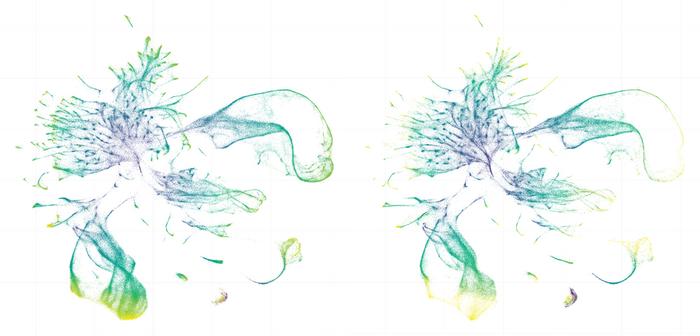In a groundbreaking exploration of evolutionary biology and developmental genetics, scientists have unveiled strikingly conserved gene expression patterns between two closely related nematode species, Caenorhabditis elegans and Caenorhabditis briggsae. Separated by an evolutionary gulf of approximately 20 million years, these tiny soil-dwelling roundworms reveal a remarkable level of cellular and molecular coherence in how their genomes are regulated during early embryonic development. This unprecedented study highlights the power of single-cell RNA sequencing to unravel the nuances of gene regulatory evolution at the most granular level imaginable: individual cells.
The essence of this research lies in the resilient preservation of gene expression programs across species that have diverged over tens of millions of years. Using single-cell transcriptomic profiling, the investigators meticulously charted messenger RNA (mRNA) abundance — a direct measure of gene activity — across virtually every cell in the worm embryo. The embryos, initially composed of a mere 28 mostly undifferentiated cells, progressively develop over roughly 12 hours into complex organisms composed of hundreds of specialized cell types. By capturing snapshots of mRNA expression at discrete embryonic stages, scientists generated a detailed lineage-resolved atlas of gene activity, allowing for a comprehensive comparison between species.
Remarkably, cell types in both C. elegans and C. briggsae maintain nearly identical gene expression landscapes, underscoring an exceptional degree of evolutionary conservation. This suggests that despite the passage of millions of years, regulatory networks governing fundamental cellular functions have been under strong purifying selection to remain unchanged. The investigators noted that genes broadly expressed across numerous cell types showed a particularly high degree of conservation. Such genes likely underpin core physiological processes vital to organismal viability, thus constraining evolutionary divergence.
Conversely, when divergence in gene expression patterns did occur, it predominantly localized to more specialized cell types, especially those involved in neuronal function and environmental sensing. These differences reflect the dynamic nature of evolutionary change, whereby adaptations necessary to navigate unique ecological niches may drive regulatory divergence in specific tissues. For instance, neurons and sensory cells might require rapid evolution to fine-tune responses to habitat-specific stimuli, accounting for the observed variability.
The technical prowess of single-cell RNA sequencing driving this research cannot be overstated. This technology isolates and sequences RNA molecules from individual cells, enabling researchers to profile gene expression without the confounding effects of cellular heterogeneity inherent in bulk tissue studies. By dissecting expression profiles in each cell, the study captures the developmental trajectory and heterogeneity within and between species with unprecedented resolution, illuminating subtle evolutionary shifts otherwise masked at the population level.
The model organisms chosen for this study, C. elegans and C. briggsae, serve as quintessential systems in genetics and developmental biology. Their transparent bodies, compact size (approximately one millimeter in length), and well-mapped cell lineages facilitate live imaging and precise cellular analysis. Moreover, their relatively modest number of somatic cells—about 550—provides an ideal framework for exhaustive single-cell profiling. Both species share roughly 20,000 genes, many of which are conserved across metazoans, linking these worms to broader biological phenomena relevant even to human health and disease.
During embryogenesis, genes toggle on and off in highly choreographed sequences to steer cells toward their destined fates. The maintenance of these gene expression programs across two species attests to the robustness of developmental regulatory circuits. The research team dispelled initial assumptions that such evolutionary distance would manifest profound divergences, instead unveiling a near one-to-one correspondence of expression profiles in homologous cell types. This coherence extends beyond mere gene presence to encompass nuanced temporal and spatial activity patterns.
However, the study’s authors caution that while the observed patterns indicate conserved developmental constraints and selective pressures, the biological reasons underlying specific divergences remain elusive. The role of genetic drift—random fluctuations in gene frequencies—and adaptive evolution in shaping these differences is a critical frontier for future investigation. Therein lies the potential to disentangle evolutionary mechanisms with precision, enabling us to understand how developmental programs evolve without compromising organismal integrity.
The implications of this research extend beyond nematodes. Since many genes analyzed have homologs in higher organisms, uncovering principles of gene regulatory conservation offers valuable insights into metazoan development, evolution, and even disease etiology. Disruptions in gene expression timing or location can precipitate developmental disorders; thus, unraveling the evolutionary logic of these programs enriches our understanding of biology’s foundational blueprints.
Notably, this study exemplifies the synergy of cutting-edge genomic technologies with classical developmental models, heralding a new era where evolution can be dissected at an unprecedented resolution. The ability to monitor gene expression changes lineage by lineage potentiates future explorations into how developmental processes evolve and adapt across the tree of life.
As this research ushers in a more granular understanding of gene expression evolution during embryogenesis, it poses provocative questions: How do selective constraints sculpt the regulatory genome? What molecular mechanisms enable the retention of cellular identity across evolutionary epochs? And how might shifts in gene regulation contribute to species-specific traits and adaptations? These questions mark exciting avenues for ongoing and future studies.
In sum, this meticulous single-cell study reveals that even after millions of years of independent evolution, C. elegans and C. briggsae share strikingly conserved gene expression landscapes during embryonic development. These findings spotlight the robustness and plasticity of developmental gene regulatory networks and underscore the intricate balance between conservation and innovation that drives evolutionary processes. This research not only deepens our understanding of nematode biology but also charts a path toward unraveling the molecular underpinnings of evolution across multicellular life.
Subject of Research: Animals
Article Title: Lineage-resolved analysis of embryonic gene expression evolution in C. elegans and C. briggsae
News Publication Date: 19-Jun-2025
Web References: http://dx.doi.org/10.1126/science.adu8249
Image Credits: Credit: Christopher R. L. Large.
Keywords: Evolutionary biology, Evolutionary genetics, Phylogenetic analysis, Molecular phylogenetics, Worms




